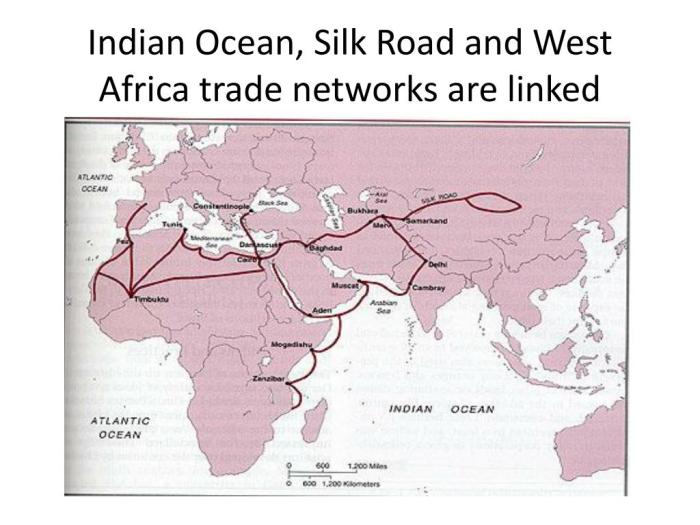The similarities between the Silk Road and Indian Ocean trade networks, two of the most extensive and influential trade routes in history, provide a fascinating subject for scholarly inquiry. These interconnected pathways fostered cultural exchange, economic growth, and technological advancements, leaving an enduring legacy on the global landscape.
Both networks spanned vast geographical regions, connecting diverse civilizations and facilitating the exchange of a wide range of commodities. From spices and textiles to precious stones and luxury goods, the Silk Road and Indian Ocean trade routes served as conduits for the dissemination of ideas, technologies, and artistic influences.
Geographical Scope

The Silk Road was a vast network of trade routes that spanned over 4,000 miles, connecting East Asia with Europe. The main routes ran from Chang’an (modern-day Xi’an) in China to Antioch in modern-day Turkey, passing through Central Asia, the Middle East, and the Mediterranean.
The Indian Ocean trade network, on the other hand, connected the Indian subcontinent with Southeast Asia, East Africa, the Middle East, and Europe. The key trading hubs along the Silk Road included Merv, Samarkand, Bukhara, and Kashgar, while major ports in the Indian Ocean trade network included Aden, Hormuz, and Calicut.
Commodities Traded

The Silk Road was primarily known for the trade of luxury goods, such as silk, spices, tea, porcelain, and precious stones. Other commodities traded along the Silk Road included horses, camels, and slaves. The Indian Ocean trade network, on the other hand, focused on the trade of spices, textiles, slaves, and ivory.
Both networks also played a role in the exchange of ideas, religions, and technologies.
Cultural Exchange: Similarities Between The Silk Road And Indian Ocean Trade

The Silk Road and Indian Ocean trade networks facilitated the spread of ideas, religions, and technologies between different civilizations. Buddhism spread from India to China along the Silk Road, while Islam spread from the Middle East to India and Southeast Asia along the Indian Ocean trade network.
New technologies, such as the compass and gunpowder, were also transmitted along these trade routes.
Political and Economic Impact
The Silk Road and Indian Ocean trade networks had a significant political and economic impact on the regions they connected. The rise of trade led to the growth of powerful empires, such as the Han dynasty in China and the Abbasid caliphate in the Middle East.
Trade also led to the development of new trade policies and the growth of global economies.
Technological Advancements
The Silk Road and Indian Ocean trade networks facilitated the development of new transportation methods, navigation techniques, and communication systems. The invention of the compass and the development of new shipbuilding techniques made it possible for traders to travel long distances and explore new territories.
The Silk Road also played a role in the development of the printing press and the papermaking process.
Artistic and Architectural Influences

The Silk Road and Indian Ocean trade networks also had a significant impact on the artistic and architectural traditions of the regions they connected. Chinese silk and porcelain influenced the development of Islamic art, while Indian textiles and architecture influenced the development of Southeast Asian art and architecture.
The spread of Buddhism along the Silk Road also led to the development of new Buddhist art forms.
FAQ
What were the key similarities between the Silk Road and Indian Ocean trade networks?
Both networks spanned vast geographical regions, connecting diverse civilizations and facilitating the exchange of a wide range of commodities, ideas, and technologies.
How did these trade routes contribute to cultural exchange?
The Silk Road and Indian Ocean trade routes served as conduits for the dissemination of ideas, religions, and artistic influences between different civilizations, fostering a vibrant exchange of cultural practices and beliefs.


